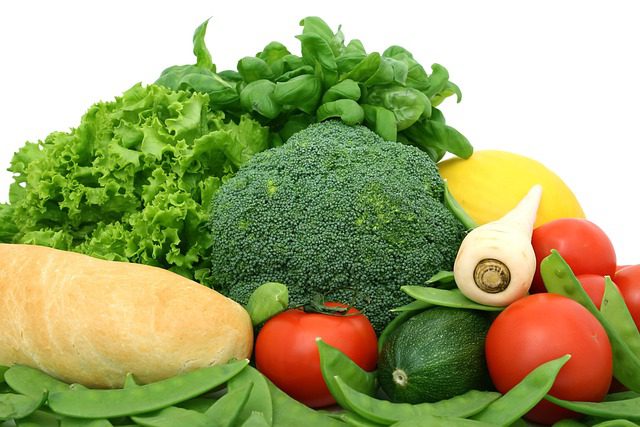You will need to closely watch the amount of salt (sodium) intake. This is because excess sodium will cause you to keep extra fluid. This will make your heart work harder. You need to limit your sodium to 2-3 grams (gm) each day.
2 gm = 2000 mg
3 gm = 3000 mg
The most common source of sodium is table salt. One teaspoon of salt has 2300 mg of sodium.
Here is one example of the importance of choosing the right food to save your heart and reduce the risk for heart disease at any age:


1 cup of canned green beans has 350 mg of sodium.
1 cup of fresh green beans has 5 mg of sodium.
Hints to lower your sodium intake:


- Take the saltshaker off the table. This can reduce your intake by 30%
- Cook without salt. This can reduce your intake by another 30%.
- Eat fresh fruits and vegetables.
- Avoid fast foods because they have a lot of sodium.
- Avoid fast foods that come from a can or jar (like pickles or olives).
- Avoid processed foods like deli meats, cheeses, or frozen meals.
- When eating out, order baked, broiled, grilled, or steamed foods. Ask that no salt be added.
- Read food labels. Choose lower-sodium foods, 150-350 mg or less per serving.
- Season food with herbs (like garlic, onion, lemon, or oranges).
- Get a low sodium cookbook. You can find one online, your library or bookstore.
- Change your recipe to low sodium.


- Choose whole grains including healthy sources of lean and/or high-fiber protein.
- Use liquid non-tropical plant oils.
- Choose minimally processed foods avoiding ultra-processed foods.
- Avoid salt substitutes. They have potassium rather than sodium. They may affect your medicines.
- Find out how much salt you can eat each day by keeping a record of what you eat and drink. You can make your own chart or print one from the website: cardiosmart.org
Fluids
Fluid Limits
Your doctor will tell you if you need to limit your fluid. Often this limit is 1500-2000 cc/day.
- 1 cup = 8 ounces
- 1 ounce = 30 cc
- One cup has 240 cc. You should have about 6-8 cups of fluid.
- (picture of measuring cup)
Here are examples of liquids and foods that count as fluid:


Drinks Other things that count
Water Yogurt
Juice Pudding (1/2 cup = 80 cc)
Coffee Soup (cream based 3/4 cup = 135 cc)
Tea Jell-O® (1/2 cup = 120 cc)
Soda Ice cream (1/2 cup = 60 cc)
Milk Juices in fruit (1 orange or ½ grapefruit = 120 cc)
Tip: If you are drinking a lot of fluid and now have to limit them, you may be very thirsty. Your mouth may feel dry. Use ice chips to help your thirst and dry mouth. One cup of ice chips equals ½ cup water and lasts longer. Frozen grapes and sugar-free hard candy can also help dry mouth.
Alcohol
When you have heart failure you will need to limit or stop drinking alcohol. Have no more than 1 alcoholic drink 2-3 times a week. If you have heart damage caused from alcohol consumption, stop drinking alcohol.


Caffeine
Caffeine is a stimulant. It can cause your heart rate to increase. This puts stress on the heart. Limit drinks with caffeine (like coffee, tea, and soda) to 2 a day.


Cholesterol and Fat
If you have a heart disease or have had a heart attack, bypass surgery, balloon angioplasty, or stent, you should eat a low cholesterol and low-fat diet. It may be easier than you think. Making small changes in what you eat can greatly decrease your risk of heart disease.
Trans fatty acids
These are found in margarine, fast food, and store baked goods. These fats are labeled, “partially hydrogenated vegetable oil” or “hydrogenated vegetable oil.” These fats are like saturated fats. They can raise LDL cholesterol and decrease HDL cholesterol. Limit your intake of trans-fat to less than 3% of your total calories. Avoid as much as possible.


Saturated fats
These are found in red meats, dairy products (like whole milk), whole milk products, palm and coconut oils. Avoid these fats in your diet. Keep your intake of saturated fats and trans fatty acids to less than 7% of your total calories. These fats increase total cholesterol and LDL cholesterol. Limit red meats. Eat chicken, fish, or turkey instead. Avoid whole milk. Drink skim milk.


Polyunsaturated fats
These are found in corn, soybean, and safflower oils. Use these fats instead of saturated fats. They may make up to 10% of your total calories. These fats lower LDL cholesterol.


Monosaturated fats
These are found in canola, olive, and peanut oil. Use these instead of saturated and polyunsaturated fats. These may make up 20% of your total calories. These fats can lower LDL cholesterol and increase HDL cholesterol.


Remember that your total fat intake includes all of these fats. It should not be more than 25-35% of your total calories. Your cholesterol intake should be less than 200 mg a day.
Your Lipid Profile
Your doctor will talk with you about your blood lipid level goals. Lipids are cholesterol, LDL, HDL, and triglycerides. The doctor will order a “fasting lipid profile” ( a blood test that checks all 4 lipids). You cannot eat for 12 hours before this test.
Cholesterol
This is a soft fat-like substance found in animal products. Some cholesterol is needed for good health. When your cholesterol is high, eating cholesterol increases your risk of heart disease. Your total cholesterol should be less than 200 mg/dl.
LDL (Low Density Lipoprotein)
This is called “bad” cholesterol because it can build up in the walls of your arteries. Your LDL should be less than 100 mg/dl. If you already know you are at risk for heart disease, your LDL should be less than 70 mg/dl.
HDL (High Density Lipoprotein)
This is called “good” cholesterol to the liver where the body can get rid of it. Good HDL levels are greater than 40 mg/dl for men and 50 mg/dl for women. A level more than 60 mg/dl is even better. Your HDL level should be as high as possible.
Triglycerides
This is the kind of fat found in the body. It is in the blood with cholesterol. A normal level should be less than 150 mg/dl.


Checking Sodium on Food Labels
Manufacturers often use certain words or phrases on labels to show the sodium (salt) content of food. These may include:
| Terms | Meaning |
| Sodium Free Salt Free Very Low Sodium Low Sodium Reduced (less) Sodium Light in Sodium | 5 mg or less of sodium per serving 5 mg or less of sodium per serving 35 mg or less of sodium per serving 140 mg or less of sodium per serving At least 25% less sodium than original version 50% less sodium than original version |


Before You Buy
Before buying food compare brands and kinds. Often products labeled “No Salt Added” have lower sodium contents than those labeled “Low Sodium.” Also beware of “Low Fat” or diet versions. These are often higher in sodium.
Other Terms to Look For
Be careful…..not all sodium is listed as “salt.” Other sodium compounds add flavor and act as preservatives. These also add sodium to your diet and will nee to be limited. They include:
- sodium nitrate
- sodium citrate
- sodium disulfate
- sodium benzoate
- monosodium glutamate (MSG)
Read the ingredient lists on all food.







